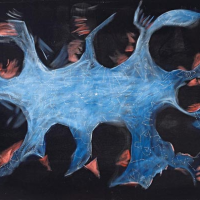91. CHARLES BLACKMAN

In this depiction of a celestial night sky, Charles Blackman creates an evocative fusion of the human and the cosmic. A leading figure in Australian twentieth-century modernism, Blackmans work has always been defined by its originality, expression of psychological complexity and profound ornamentation.1 The present work Song of The Flute is a classic example of Blackmans imaginative vision.
Blackman forged his career in the vibrant artistic milieu of 1950s and 1960s Australia. He was a member of the infamous Antipodean group of figurative painters, who, led by Bernard Smith (1916-2011), arose in backlash to the dominance of abstraction in contemporary painting. Two years later in 1961 his work featured in the seminal exhibition Recent Australian Painting at Whitechapel Gallery in London, curated by Bryan Robertson. Robertson arrived in Australia in 1960 and discovered an exciting raft of painters such as Arthur Boyd (1920-1999), Sidney Nolan (1917-1992) and Charles Blackman. These artists were doing something new, interesting, and uniquely Australian, and Blackman was at the vanguard of this Australian school of contemporary art.
By the early 1980s when the present work was created, Blackmans success locally and in the UK was well established. He married artist, ceramicist, and jeweller Genevive de Couvreur (born 1958) in 1981, and the couple moved to the small town of Buderim on Queenslands Sunshine Coast. With renewed creative vigour inspired by his recent marriage and the fecund natural surrounds of his coastal hinterland home, Blackman embarked on this new series and diversified his thematic vocabulary.
Blackman also began working on several projects where his idiosyncratic style and poetic surrealism found new forms of visual expression in the set and promotional designs for ballet and theatre productions. In 1982 he collaborated on the Sydney Dance Companys production Daisy Bates, a performance piece based on the life of a white woman who lived with Aboriginal communities in central Australia at the turn of the century.
In this period, the night sky emerged as a motif for the artist, one which may have had its roots in his theatre work. Shapcott notes that It is in the sense of space, the vastness of the Australian night sky, that Blackmans most persuasive feeling for the world of Daisy Bates finds expression.2 It was not until 1988 that his interest in starry skyscapes reached a pinnacle in the ambitious theatre collaboration, The Celestial Mirror, a bicentenary project commissioned by the West Australian Ballet and performed around Australia. In her review of The Celestial Mirror, critic Jill Sykes wrote of Blackmans set design:
At first, there is just a starry tracery of human and animal outlines on the backcloth. Then the lights come up to reveal a circle of shadowy heads around the perimeter: its as though the audience is in a deep hole, with people peering out of a brilliantly clear desert night sky above. The theatrical power of this design is amazing, and quite disorienting in an exhilarating way.3
This description could equally be said of Song of The Flute, which was created approximately six years prior, thus revealing Blackmans early arrival at the idea to depict a night sky surrounded by shadowy figures. It is a composition that arouses wonder and curiosity, with its unusual perspective and ambiguous faces. They might be looking into a deep rockpool that reflects the starry skies above, or perhaps they occupy a spiritual plane, as ancestral guardians gathered at the edges of the night sky. Blackman leaves the paintings interpretation to the viewer, yet his combination of elusive figures with a night sky filled with animal shapes delineated as points of light, creates an effect that is undeniably magical.
This, and other works produced in the 1980s, illustrate a blossoming of diverse subject matter that evolved within Blackmans oeuvre during this period, while retaining the hallmarks of the artists particular, dreamlike vision.
Footnotes:
1. Shapcott, T., Artists in Queensland; Focus on Charles Blackman, University of Queensland, Brisbane, 1967, p.15
2. Shapcott, T., The Art of Charles Blackman, Andre Deutsch Limited, London, 1989, p.72
3. The Sydney Morning Herald, 5 October 1988, quoted in Shapcott, T., The Art of Charles Blackman, Andr Deutsch Limited, London, 1989, p.73
Marguerite Brown
Marguerite Brown is an independent arts writer and curator based in Melbourne, and General Manager of the Print Council of Australia Inc.